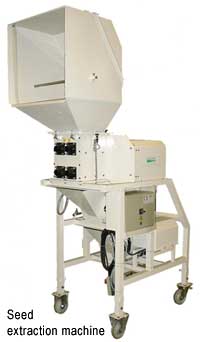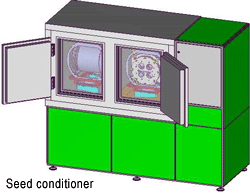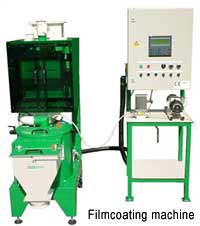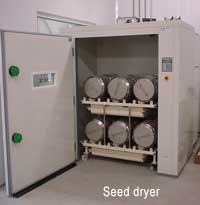Early seed experiences and how
I got started
In 1949 my father got a job as a manager on a seed trial
farm in Heerhugowaard, a small village near Enkhuizen. There the
whole family was working in the field during the harvest,
threshing the seeds. I can remember that the tomatoes were grown
in the open field and, when they where ripe, they were collected
into a small boat. After a few days of fermentation, we, the
children, got some high boots and were told to crush the
tomatoes in the boat for the seed extraction process. I did not
know at that moment that in future time I would develop a
machine to do this process automatically.
After a few years we returned to Enkhuizen because my father
wanted to give his children a chance to study.
I studied at a technical college in Hoorn. Every day I had to
bicycle 40 km (25 miles). At a young age I started to work at a
local construction company. In the evening I took lessons to be
a designer (engineer).
After 2 years of military service as an officer in the
engineering corps, I was offered a good job in Switzerland. I
worked there for 2 years. Then I started to work in Enkhuizen
again, but after I lost my job one day my farther-in-law gave me
the advice to start my own company, so I could be independent.
The first years
 In
1967 I started my own small construction shop in Enkhuizen
called van Dok & de Boer. The company was located in the
backyard of Royal Sluis Seeds (now part of Seminis Vegetable
Seeds). The people at Royal Sluis needed parts for both new and
older equipment. My company was building equipment and parts
only for Royal Sluis. In those days, seed companies did not
exchange information with each other, they did not like it when
suppliers were selling to other competing seed companies. In
1967 I started my own small construction shop in Enkhuizen
called van Dok & de Boer. The company was located in the
backyard of Royal Sluis Seeds (now part of Seminis Vegetable
Seeds). The people at Royal Sluis needed parts for both new and
older equipment. My company was building equipment and parts
only for Royal Sluis. In those days, seed companies did not
exchange information with each other, they did not like it when
suppliers were selling to other competing seed companies.
Because my company had a lot of work in all kinds of
construction work, we moved to another facility in an
industrial area in Enkhuizen. During the construction of
expanding the building, there was an accident which burned
the whole facility down to the ground. This was a difficult
period for me. Only some drawings of seed processing
equipment were saved. Looking at those drawings, I started
to wonder whether this equipment could be sold
worldwide? I made the decision to start up again and focus
on equipment only for the seed industry.
We wanted to be different in the marketplace. We wanted to
offer complete processing lines. We saw that there was a
need for this worldwide. At that time we changed our name
from "van Dok & de Boer" into "Seed Processing Holland BV",
because this new name told our potential customers exactly
what we were doing.
As the Dutch seed industry was expanding rapidly in those
days and was breeding and producing seed around the world,
we also got opportunities to export to foreign countries.
This had a impact on the local seed companies of these
countries, which helped us a lot selling our equipment.
What it took
to succeed
The market in which
we operate is relatively small. To be a seed machinery
manufacturer in the Netherlands, you have to distinguish
yourself from other suppliers around the world.
 Because
labour costs are high in the Netherlands, we have to produce
high quality machines to have the right to exist in this
business. Because
labour costs are high in the Netherlands, we have to produce
high quality machines to have the right to exist in this
business.
Our machines have to be original,
accurate and reproductible, and we must provide good support
to our customers around the world. Today, because of the new
technologies, we can support some of our products, such as our
seed dryer, filmcoater and priming system, electronically via
modem.
We export to some 60 countries, and
23 people work in the company. In order for us to best advise
our customers on the equipment they need, companies can send
us small seed samples for testing, free of charge. In our
showroom we have all the basic equipment. We can do tests for
seed cleaning (conditioning), colour sorting, priming,
counting, drying and chlorophyll sorting etc. We return the
samples with our recommendations. In this way the customers
know that, when they buy our equipment, it will work for their
seeds. Early
evolution of seed machinery and equipment
There has always been a fundamental need for
cleaning seeds which goes back centuries.
Sorting
seeds on size, weight and colour can improve the quality of a
seed lot. These sorting activities were mainly done by hand.
More than 100 years ago, you could already see in some seed
companies a certain level of automation such as air separators
(winnower) or air screening machines.
In order to get better seed quality
"high germination was always an issue". Seed companies tried to
find better and more automated separation techniques. Some
techniques where borrowed from other processing industries
such as the food and pharmaceutical industries.
A few milestones
in the seed equipment industry
Seed Gravity Separator
Based on seed weight, this machine
separates light and heavy seeds/parts in several fractions. In
the past this technique (roll up) was done by hand, it was and
still is a very difficult technique, and only a few skilled
seed cleaning specialists can do it.
Seed Colour Separator
Based on the colour of the seed, this
machine can separate a seed lot. It works with cameras. For
example you can remove infected black seeds out of tomato or
pepper seed, black lettuce seed from white seed, green beans
from white beans, etc. Nowadays we sell colour separators that
can separate many tons of seed per hour.
 Seed
Priming Seed
Priming This technology enhances seeds,
which will give the grower a faster germination, more
uniformity, more first choice plants etc. In principle, 4
different seed priming methods are available: Drum Priming,
Solid Particulate Priming, Osmotic Priming and the Seed
Conditioner (water vapour pressure
conditioning). We sell equipment for two methods:
Osmotic priming and the Seed Conditioner.
Seed Pelleting
This process came from the
pharmaceutical industry. Making the shape of a seed different,
using powders and liquid. Seed that is difficult to sow, such
as begonia
or lettuce, can be pelleted. The nice round shape of the seed
pellet makes it very easy to sow, and prevents double seeds in
trays or in the field. We offer the complete pelleting
equipment range.
 Seed
Sizing (Calibrating) Seed
Sizing (Calibrating)With
very accurate screens, in a fairly slow process, "naked" seeds
can be sized on the diameter with 0.05 mm difference (100e
inch). In this way you can separate male and female lines,
but also create again uniformity in plants.
Nowadays the market is more and
more demanding sized seeds.
Our sizers are used mainly in flower
and vegetable seed processing.
 Seed
Counting Seed
Counting
Using cameras. this process counts seeds 1 by 1.
Instead of selling seeds by volume or by weight, seeds can be
counted as well. In this way you are not depending on the DKG
(thousand corn weight). You can actually sell exactly the
seeds that you need to sell. Therefore you will never sell too
much seed, which will save you money in the end. We developed
a wide range of counting equipment to do this.
Seed Chlorophyll Sorting
Using laser technology. Reading the
quantity of chlorophyll fluorescence in the seeds, you can
sort on the maturity level. In this way you have the
possibility to separate mature and immature seeds. This could work
for example for brassicas, peppers, tomatoes etc.
How
equipment is developed
As an
example, 20 years ago seed companies used to come to me and
to tell me about the problems they had with damage to seeds
during the threshing and extraction processes. It is very
important to listen to the problems the seed companies are
experiencing and to find the solution together. We could not
develop our equipment without the practical experience of
the seed companies. Together with the seed production
managers and the technical managers we started to design
machines. Most of the time the result was that we got the
order to build the equipment. Agreements were then drafted
which specified whether or not we could sell the new
equipment to other seed companies.
In this way we developed rotary
seed threshers, belt threshers and seed extraction machines.
Seeds where no longer damaged in the beginning of the
process so this would prevent a lot of problems in seed
cleaning and germination. These machines were and
are particularly successful in our company.
 Another
problem the companies had was with the drying of seeds. Seed
companies dried their seeds with non-conditioned ambient air.
This meant that a drying process could take 2 days or maybe
a week, depending on the ambient air conditions. This could
mean that the seed quality could go down, because seeds
remained wet for too long. After studies, it appeared that
drying in a controlled conditioned way could keep a good
germination / quality of the seed lot. Another
problem the companies had was with the drying of seeds. Seed
companies dried their seeds with non-conditioned ambient air.
This meant that a drying process could take 2 days or maybe
a week, depending on the ambient air conditions. This could
mean that the seed quality could go down, because seeds
remained wet for too long. After studies, it appeared that
drying in a controlled conditioned way could keep a good
germination / quality of the seed lot.
We listened to these problems and
we developed our own conditioned drying system. We began
also to rotate the seeds during the drying, in order to have
a uniform drying process, no double seeds and a polishing
effect (like on tomato). This was something the market was
waiting for. This dryer is still very successful because you
can use it for all kind of seeds or pellets and every
harvest year under each ambient weather conditions you can
have the same quality drying process. "You know what you are
doing"
Because we have a good reputation
in the market we also notice that inventors of universities
or individuals contact us to work together on creating a new
or improved seed processing technique. Sometimes this
results in a new machine, but you always have to pay
attention to the
market and determine whether this is really what companies could use
in practice.
Equipment must be practical in use.
Prevent high tech bottoms if you do not need it. I hanged a
sign in our engineering department reading "KISS". My
designers asked me what it meant. I told them ""Keep It
Simple Stupid"". I hope that they learned something from
these 4 words. Unforgettable moments
I will
never forget some experiences I had during my travels.
One time I was in Indonesia (Java)
for a survey on a seed cleaning project. During a walk through
the trial fields, I met the seed growers. They where so proud
and honoured that I visited them, that I got a bag of potatoes
to bring back with me to Holland. Of course I accepted this
gift, which was a serious deal for those people. I had to
carry this 25 Kg bag a few miles over the Sawas as we where
walking on, knowing that I could never cook them in my hotel
or take them home with me.
In Russia, Kazakhstan we also
finished a seed cleaning project. The Ministry of Agriculture
supported this. During a ceremony as an honoured guest, I was
rewarded with a medal as best worker of Kazakhstan. I had to
wear a traditional costume and they prepared a cooked sheep
head. I had to cut this head, and I had to give it to the
other guests on the table. Each part of the head had a
different meaning, like the ears (the person who got this,
could listen well) the eyes (you noticed every small detail)
etc. I was lucky I had a strong stomach and a good appetite!
In the 80ís in Algeria the FAO
completed a project financed by the World Bank, to privatise
the agricultural industry. This could mean orders for
suppliers of tractors or sowing equipment, but also of seed
extraction and threshing equipment. We worked on this project
with a consultant who spoke French and I was there for
technical support. There was also a German supplier of potato
planters. He said he could deliver 500 of these machines. He had a
brochure with a picture showing another machine (more
expensive) than the one he had offered. The Algerian buyers demanded
that he delivers the equipment mentioned on the picture at
the price of his quote for the other, less expensive machine. This misunderstanding would cost
him $50.000 and he did not want to agree. The Algerians
asket him to make an offer for 1,500 machines, which would end
up costing him $150,000. He flew back to Germany, doing his
calculations over and over again. I learned then that you should be
careful how you describe your offer and that your
documents have to be correct.
In closing
I am proud that we are accepted
worldwide by the seed companies, and I believe that our
customers like the fact that we visit them each year. We are also
members of the ASTA, APSA and ISF. By attending the
conferences of these associations we can inform our customers regularly about new
technologies and developments.
 Because
I am an engineer, I am very happy that we draw our equipment
in 3-D. We can also communicate with architects around the
world on turnkey projects. We send the drawings by email back
and forth. Because
I am an engineer, I am very happy that we draw our equipment
in 3-D. We can also communicate with architects around the
world on turnkey projects. We send the drawings by email back
and forth.
When I look back, I do not think I
would do things differently if I had to start again. You loose
some and you win some, as the saying goes. Of course, we had
our share of difficult times, for instance when the economy was slow in the
early nineties. But this is the risk I took as an
entrepreneur. I always stood behind our products. During my career
I have witnessed the evolution in communication technology
like telex, fax, email and Internet. We used this a lot. I was
fascinated by these quick developments.
I have now been retired for over a
year. I must say that after 45 years of working hard I rather like
it,
although it took me more than half a year to get used to it. I
did not have appointments! And now I think I can make
appointments with my wife, but she does not want to do this,
what can I do?
Anyway I know that the company is in
good hands. And I hope that they have the same luck and
opportunities in business that I once had.
If you want to know more about our
company and products you can visit us at:
www.seedprocessing.nl
or contact us at:
info@seedprocessing.nl
|